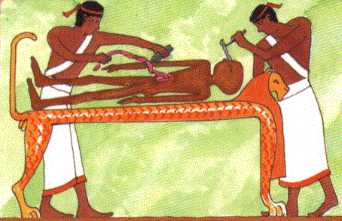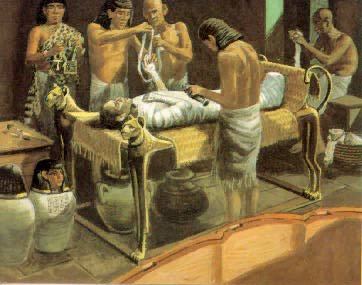Ancient Egypt is famous for the customs they practiced and the rituals they observed. Among Egyptian traditions and practices, the most important and the most famous is the funerary process called mummification. They had exceptional beliefs about the afterlife and the concept of rebirth and soul which they tried to exhibit through embalming process. The nature of the process varied according to the social status of the individual.
 Embalming and the associated ceremonies were conducted by embalming priests. The process of embalming and mummification required that microbial growth and dehydration was inhibited. The embalming process and creating a mummy was complicated and costly and was surrounded with ceremony and ritual.
Embalming and the associated ceremonies were conducted by embalming priests. The process of embalming and mummification required that microbial growth and dehydration was inhibited. The embalming process and creating a mummy was complicated and costly and was surrounded with ceremony and ritual.
Cleansing and Purification Process
The process lasted for a period of 70 days. Cleansing and purification took 15 days. The corpse was to be dried for a period of 40 days. Wrapping, Bandaging, and painting took 15 days. The embalmer’s tools included bronze hooks, knives, tweezers, needles and awls (a pointed tool) for opening, emptying and closing up the corpse.
The mummification process which included the removal of organs was conducted on a special slightly slanted table which allowed the blood and bodily fluids to drain into a built-in basin.
Embalming Shop
As soon as a person died, the body was taken to an embalming shop and the price was fixed for the procedure. The corpse was washed and ritually purified. It was washed with palm wine to kill bacteria and rinsed with water from the Nile. The corpse was then taken to the Ibu, the ‘place of purification’.
 A long hook was used to smash the brain and pull it out through the nose. The resin was poured into the brain which then solidified to prevent the skull from collapsing. Any fluid drained from the brain was discarded. The brain was regarded as useless and probably thrown away.Then a slit was cut into the body and the inner organs; the intestines, the liver, the stomach and the lungs were removed and preserved in canopic jars. The canopic jars were filled with crystals of natron. The heart remained within the body because it was believed that the heart was to be weighed for the final judgment of the deceased.
A long hook was used to smash the brain and pull it out through the nose. The resin was poured into the brain which then solidified to prevent the skull from collapsing. Any fluid drained from the brain was discarded. The brain was regarded as useless and probably thrown away.Then a slit was cut into the body and the inner organs; the intestines, the liver, the stomach and the lungs were removed and preserved in canopic jars. The canopic jars were filled with crystals of natron. The heart remained within the body because it was believed that the heart was to be weighed for the final judgment of the deceased.
Process Of Embalming
The body and the cavity in the abdomen were packed with small sacks of natron. It served to dry out the organs and discourage bacteria from decaying the tissues. The drying process took forty days, after which the natron was removed, inside and out, to reveal a dried, shrunken body.
The corpse was again cleaned with water; mummies were ritualistically anointed with oils and perfumes to help the skin stay elastic. The body is stuffed with dry materials such as sawdust, leaves, and linen so that it looks lifelike.
 The body was adorned with gold, jewels, and protective amulets. Fingers and toes were covered with protective gold caps and individually wrapped with long, narrow strips of linen. Finally, the body is covered again with good-smelling oils. It is now ready to be wrapped in linen.
The body was adorned with gold, jewels, and protective amulets. Fingers and toes were covered with protective gold caps and individually wrapped with long, narrow strips of linen. Finally, the body is covered again with good-smelling oils. It is now ready to be wrapped in linen.
Linen bandages were used to bind the extremities. The entire mummy was wrapped to a depth of about twenty layers. The embalmers used resin to glue the layers of wrappings together. The wrapped head was covered with a mummy mask. The last layer of bandages went on and was given one last coating of resin.The very many rituals associated with embalming might have countless mysteries which the modern world may yet fail to perceive.